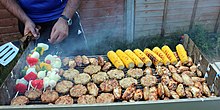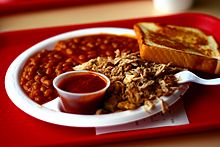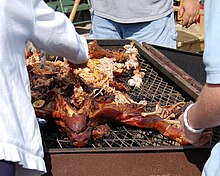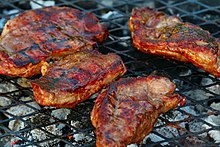
Grilling is a form of cooking that involves heat applied to the surface of food, commonly from above, below or from the side. Grilling usually involves a significant amount of direct, radiant heat, and tends to be used for cooking meat and vegetables quickly. Food to be grilled is cooked on a grill, using a cast iron/frying pan, or a grill pan.
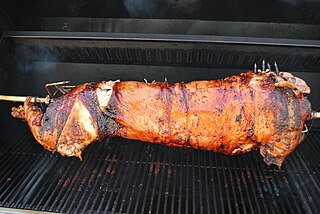
Roasting is a cooking method that uses dry heat where hot air covers the food, cooking it evenly on all sides with temperatures of at least 150 °C (300 °F) from an open flame, oven, or other heat source. Roasting can enhance the flavor through caramelization and Maillard browning on the surface of the food. Roasting uses indirect, diffused heat, and is suitable for slower cooking of meat in a larger, whole piece. Meats and most root and bulb vegetables can be roasted. Any piece of meat, especially red meat, that has been cooked in this fashion is called a roast. Meats and vegetables prepared in this way are described as "roasted", e.g., roasted chicken or roasted squash.

Smoking is the process of flavoring, browning, cooking, or preserving food by exposing it to smoke from burning or smoldering material, most often wood. Meat, fish, and lapsang souchong tea are often smoked.

Brisket is a cut of meat from the breast or lower chest of beef or veal. The beef brisket is one of the nine beef primal cuts, though the definition of the cut differs internationally. The brisket muscles include the superficial and deep pectorals. As cattle do not have collar bones, these muscles support about 60% of the body weight of standing or moving cattle. This requires a significant amount of connective tissue, so the resulting meat must be cooked correctly to tenderise it. According to the Random House Dictionary of the English Language, Second Edition, the term derives from the Middle English brusket which comes from the earlier Old Norse brjósk, meaning cartilage. The cut overlies the sternum, ribs, and connecting costal cartilages.
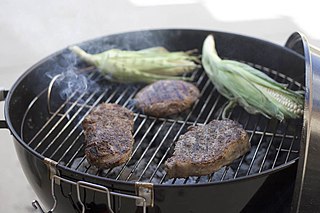
A barbecue grill or barbeque grill is a device that cooks food by applying heat from below. There are several varieties of grills, with most falling into one of three categories: gas-fueled, charcoal, or electric. There is debate over which method yields superior results.

Indirect grilling is a barbecue cooking technique in which the food is placed to the side of or above the heat source instead of directly over the flame as is more common. This can be achieved by igniting only some burners on a gas barbecue or by piling coals to one side of a charcoal pit. A drip tray is placed below the food to prevent fat from the food igniting and generating a direct flame. Indirect grilling is designed to cook larger or tougher foods that would burn if cooked using a direct flame. This method of cooking generates a more moderate temperature and allows for an easier introduction of wood smoke for flavoring.

St. Louis–style barbecue refers to spare ribs associated with the St. Louis area. These are usually grilled rather than slow-cooked over indirect heat with smoke which is typically associated with the term "barbecue" in the United States. Often overshadowed by its more famous cousin, Kansas City–style barbecue, St. Louis–style barbecue struggles to distinguish itself from other city based styles of barbecue. Although St. Louis–style barbecue takes inspiration from other styles of barbecue it still retains its own distinct style.
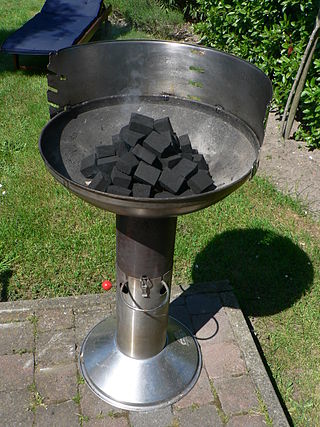
Barbecue varies by the type of meat, sauce, rub, or other flavorings used, the point in barbecuing at which they are added, the role smoke plays, the equipment and fuel used, cooking temperature, and cooking time.

Barbecue sauce is a sauce used as a marinade, basting, condiment, or topping for meat cooked in the barbecue cooking style, including pork, beef, and chicken. It is a ubiquitous condiment in the Southern United States and is used on many other foods as well.

Barbecue is a tradition often considered a quintessential part of American culture, especially the Southern United States.

Barbecue chicken consists of chicken parts or entire chickens that are barbecued, grilled or smoked. There are many global and regional preparation techniques and cooking styles. Barbecue chicken is often seasoned or coated in a spice rub, barbecue sauce, or both. Marinades are also used to tenderize the meat and add flavor. Rotisserie chicken has gained prominence and popularity in U.S. grocery markets. Barbecued chicken is one of the world's most popular barbecue dishes.

Inihaw, also known as sinugba or inasal, are various types of grilled or spit-roasted barbecue dishes from the Philippines. They are usually made from pork or chicken and are served on bamboo skewers or in small cubes with a soy sauce and vinegar-based dip. The term can also refer to any meat or seafood dish cooked and served in a similar way. Inihaw are commonly sold as street food and are eaten with white rice or rice cooked in coconut leaves (pusô). Inihaw is also commonly referred to as Filipino barbecue or (informally) Pinoy BBQ.

Texas Barbecue refers to methods of preparation for barbecue unique to Texan cuisine. Beef brisket, pork ribs, and sausage are among the most commonly known dishes. The term can also include side dishes that are traditionally served alongside the smoked meats.
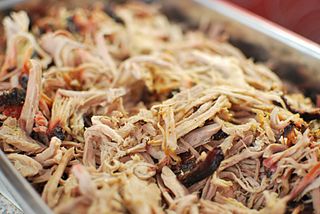
Barbecue is an important part of the heritage and history of the U.S. state of North Carolina. It has resulted in a series of bills and laws that relate to the subject, and at times has been a politically charged subject. In part, this is due to the existence of two distinct types of barbecue that have developed over the last few hundred years: Lexington style and Eastern style. Both are pork-based barbecues but differ in the cuts of pork used and the sauces they are served with. In addition to the two native varieties, other styles of barbecue can be found throughout the state.

A barbecue restaurant is a restaurant that specializes in barbecue-style cuisine and dishes. Barbecue restaurants may open relatively early compared to other restaurants, in part to optimize sales while barbecued foods being slow-cooked by the process of smoking are being tended to by restaurant personnel on premises. In some instances, this can enable the sales of barbecued meats that began being smoked the night before the next business day. Per these logistics, a significant portion of their sales may occur during lunchtime. Additionally, high lunch turnover at barbecue restaurants may occur per the foods being cooked and sold in large batches. Popular food items may sell out earlier compared to others, which may encourage customers to arrive earlier. In January 2015, the U.S. National Restaurant Association forecast "barbecue, Italian food and fried chicken" to be "top perennial menu favorites in 2015".



